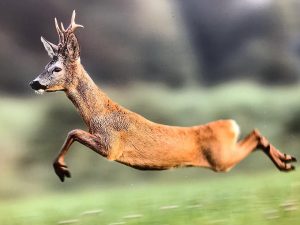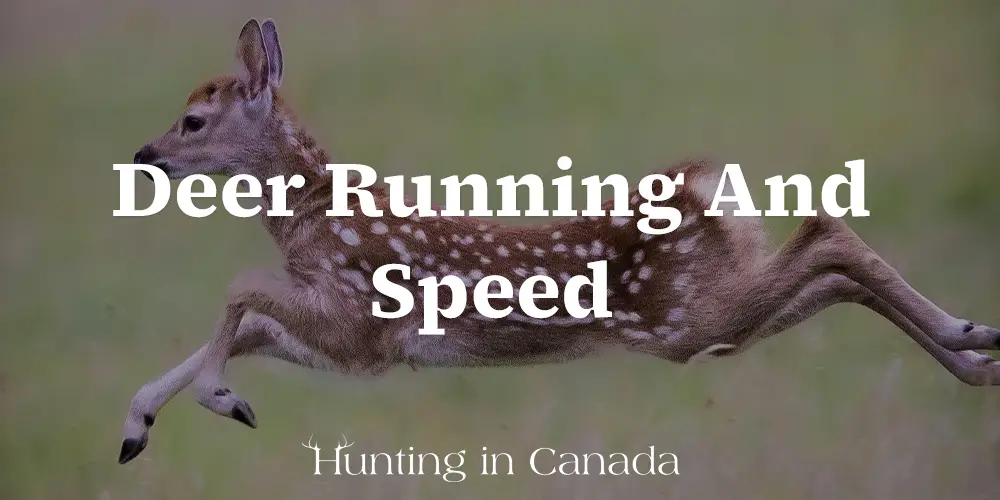Deer Running And Speed / Everything You Need To Know
The deer is a tricky animal, often seen as elusive and quick. Hunters strive to learn everything they can about their prey in order for them to have higher chances of success when hunting it down.
Knowing the speed of a running deer and when they are about to run is important when you are out in a hunting stand, waiting for that big buck to step into view. This information might help you decide whether or not you should take the shot.
Deer are fast animals. They have to run away from many predators in their environment, such as Coyotes, wolves, bears and more. When they’re really motivated, they can hit speeds of 35-40 miles per hour. But just like humans, deer rarely hit their top speed.
So whether you are an experienced hunter or just getting ready for your first hunt, read this blog post to learn more about deer running and speed.

Factors Affecting The Deer Running Speed
The speed at which deer can run is determined by several factors. Some of these factors include:
Age: When a deer is young (under one year old), it can’t run as fast as older deer because they are still growing and haven’t reached their full potential.
Weight: Speaking about deer sprinting speed, whether it is a deer buck or deer doe, heavier deer can usually outrun lighter ones because they have more muscle mass.
In most cases, the buck running has a speed that can exceed the doe. Male deer are more agile and have larger hooves that help them outpace females when they’re on a hot pursuit.
Health: There is no doubt that a healthy deer will be able to run faster than an unhealthy deer.
Terrain: The deer’s speed is determined by the type of terrain it runs on. They will be able to run faster on the open ground than they will in densely forested areas.
How Fast Can a Deer Run?
Deer can run, but they don’t always maintain a steady speed. The threat affects their speed and the type of deer in question as well. There are many types of deer; for instance, the average speed of Whitetail Deer running can reach up to 30 miles per hour, and it can jump 8 feet high and cover distances of up to 25 feet. The White-Tailed Deer get their name from the white fur underneath their tails.
And there are also other types like Mule deer, Red deer, Fallow deer, Moose, Wapiti, European roe deer, and more. The distance of deer jumping differs from one to another, and so does the average speed.
Normally, a deer would only run to escape predators. When a deer senses danger, it will run for its life. However, that’s not the only circumstance that can lead a deer to run at high speed. In the mating season or rutting season, bucks are driven by high testosterone levels and can move quickly to pursue female deer or doe.
How to Tell a Deer is About to Run?
If you want to know if a deer is getting ready for an escape, then look at its body language. This could be when they have to communicate with each other to define dominance or to communicate to other deer around them to know that danger is nearby.
In terms of their body language, deer are often making distress signals before they are about to make a run for it. There are different ways with which they can do this, one of them is by flagging. Something that is a well-known signal of White-Tailed deer.
They do this by raising their tail to show the white undersides. The tail is pointed upwards firmly, which indicates that danger is nearby and they are going to run very soon.
There is another way to know that the deer are about to run – this one is by noticing their tail and rump flare up. This is also another way for a herd of deer to warn each other to be alert.
This time, it means the danger is impossible to ignore, and the imminent danger is close. When you see a deer whose rump is flaring or that is flagging, you can be confident that the deer is about to bolt.
How does a Deer Avoid Predators?
The wild deer runs away for safety, so having an idea of how it will run will be a good advantage as you will be able to predict its movements.
It’s important to know that deer need to conserve energy. So not all deer can run at high speeds for long periods of time. For that reason, they employ a lot of defensive strategies with their running. Also, they will be more careful during the winter months when food is scarce.
When deer sense danger, they will often run and try to lure the predator towards a trail that they are familiar with. These trails would often make it difficult for predators and slow them down as they will have lots of obstacles.
In this way, the deer’s familiarity with the local obstacles will be their advantage, they can use it to find safety faster.
Many deer run in zigzag motions, which is a defensive maneuver. With zigzag motions, they also run with fidgeting impulses. Deer running this way in order to be able to sense danger and avoid any predator that is chasing them
The switching of directions will allow deer to have a good view of any predators that are in pursuit and often can confuse the predators and prevent them from catching up to them.
The deer is an animal that can jump over fences and obstacles seven feet high and more If they are running at full speed. At full speed, the distance they could cover in one leap would be as much as 30 horizontal ft when danger is near.
How Fast Can a Deer Swim?
The deer is a strong swimmer and can easily swim for long distances if necessary. Their heads usually stay above water when swimming, but they can dive underwater to escape predators.
Deer are usually not very eager to swim; they usually swim when they have to. They prefer to stay on land where they can run away from predators. When you see a deer in the water, it’s likely because they are trying to escape from any predators or a wild animal that is chasing them.

